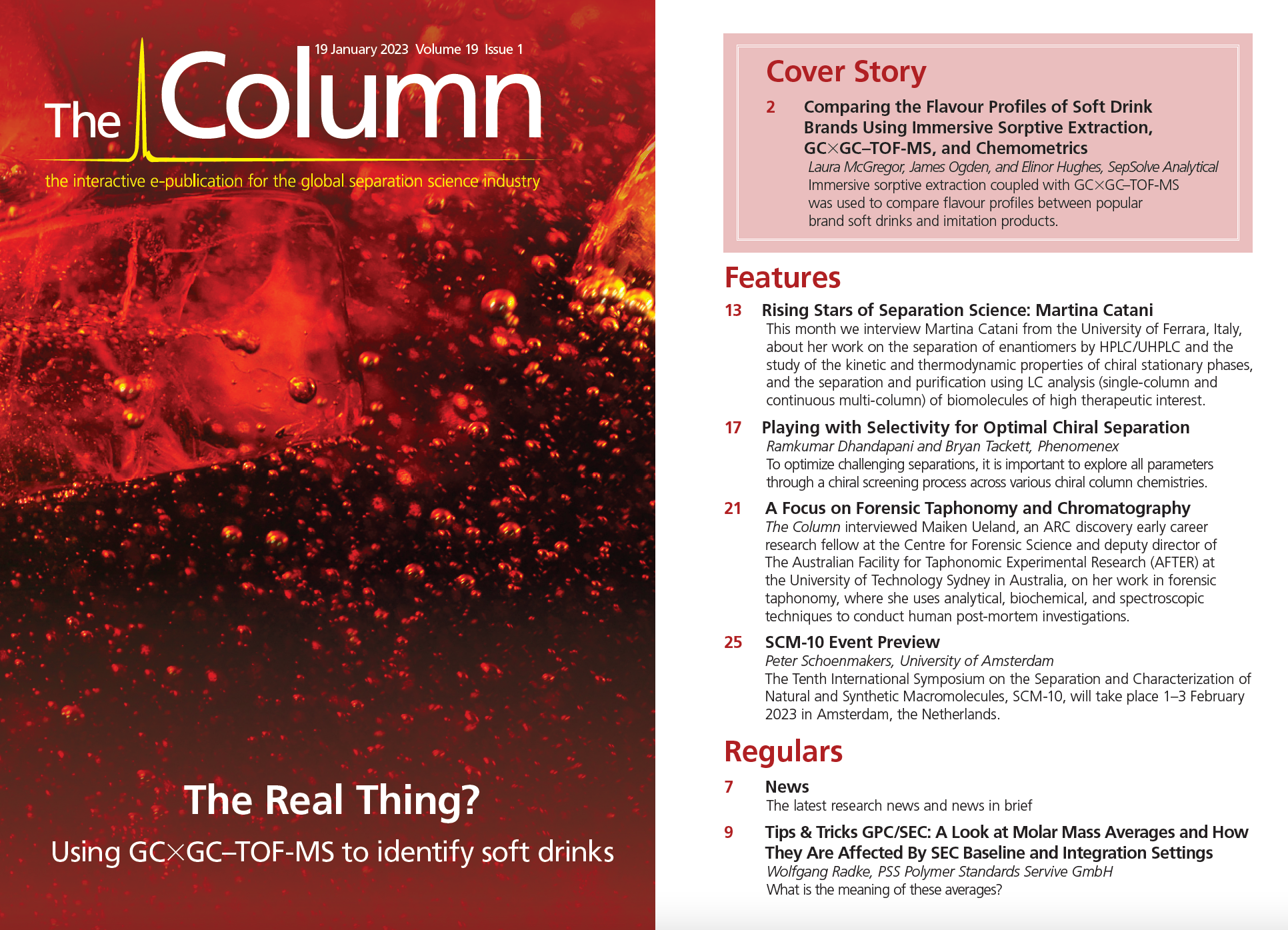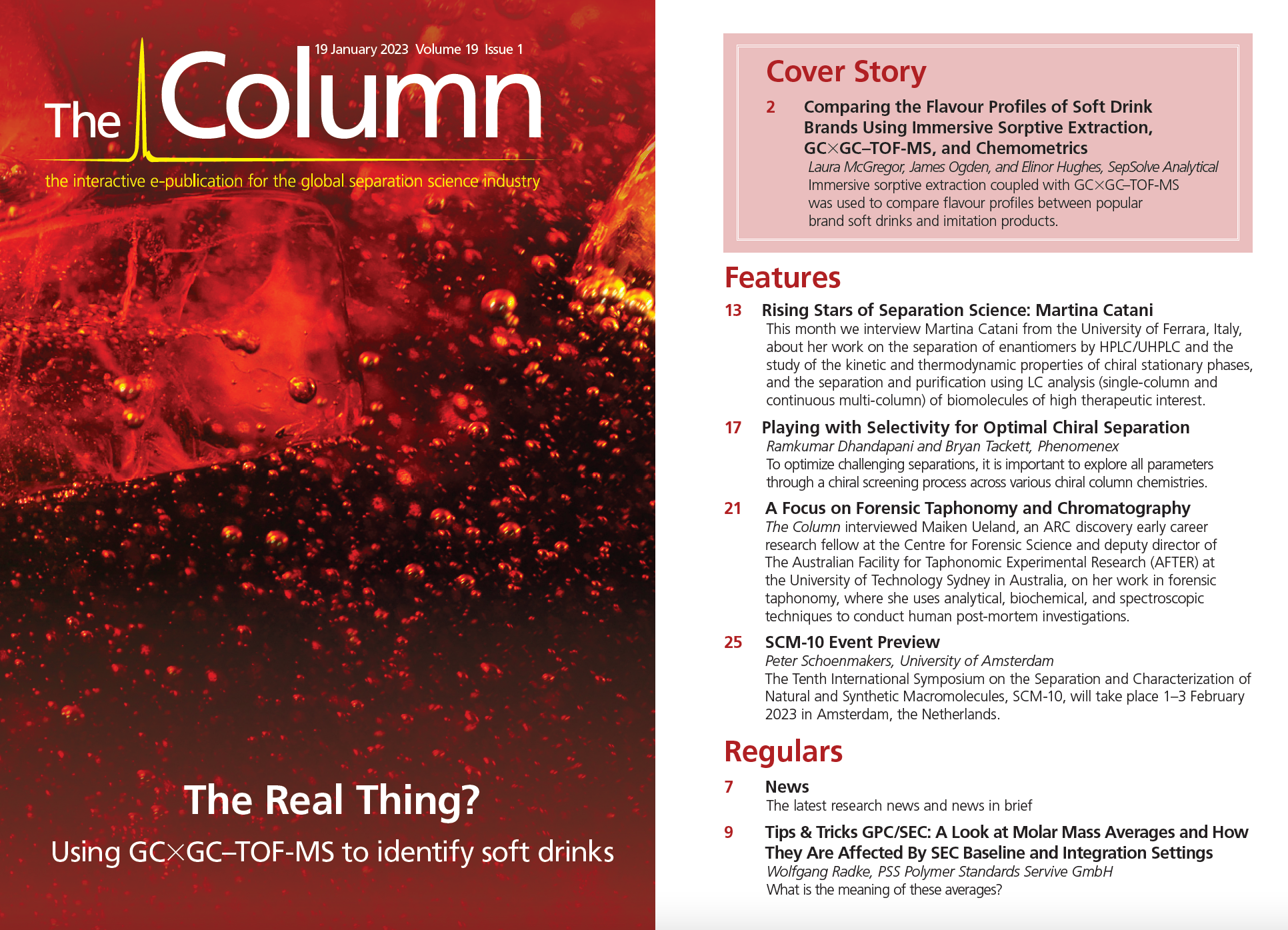Rising Stars of Separation Science: Martina Catani
This month we interview Martina Catani from the University of Ferrara, Italy, about her work on the separation of enantiomers by high performance liquid chromatography/ultrahigh-pressure liquid chromatography (HPLC/UHPLC) and the study of the kinetic and thermodynamic properties of chiral stationary phases, and the separation and purification using LC analysis (single-column and continuous multi-column) of biomolecules of high therapeutic interest.
Q. When did you first encounter chromatography and what attracted you to the subject?
A: The first time I encountered chromatography was during my bachelor’s degree in chemistry. Even though at that time I was only studying it from a theoretical point of view, I became fascinated by the great versatility of this technique and its capability for understanding the composition of unknown complex mixtures. However, the moment at which I said, “OK, this is what I would like to do for the rest of my life” was during my master’s thesis. My work was focused on the design of enzymatic packed‑bed microreactors for the enantioselective formation of C–C bonds in aqueous environment. I had the opportunity to functionalize silica particles with the enzyme, to pack the columns with this adsorbent, and to fully characterize the performance of the microreactor not only in terms of catalytic conversion but also from a chromatographic point of view. In addition, since the scope of the work included the evaluation of the enantiomeric excess of the products, I also performed several enantioseparations by using a chiral column in gas chromatography (GC) and I started developing a passion for separating enantiomers (a topic that is still dominating a great part of my work).
During that period, I started seriously thinking about the idea of pursuing a Ph.D. in analytical chemistry—especially based on chromatography.
Q. Can you tell us more about your Ph.D. thesis?
A: I started my Ph.D. in 2014 at the University of Ferrara under the supervision of Alberto Cavazzini. My Ph.D. project was mainly focused on the investigation of theoretical aspects of liquid chromatography (LC), including mass transfer characteristics and thermodynamic properties of different kinds of porous media commonly used for ultrafast, high efficiency separations. I considered not only achiral adsorbents (such as C18 or perfluorinated stationary phases) but also (and especially, I would say) chiral ones.
In this context, I performed innovative studies to unravel the complex mass transfer phenomena dominating kinetics of chiral chromatography and I also investigated the thermodynamics of adsorption through nonlinear chromatographic means (namely, adsorption isotherm determination). In particular, these investigations were devoted to the understanding of the impact of kinetic aspects (adsorption–desorption kinetics and eddy dispersion), particle geometry (fully porous vs. core–shell), and physicochemical characteristics (specific loading of chiral selector, pore size) on the performance of these columns.
These studies not only opened up new perspectives in this field by reviving the debate about the best particle format for ultrafast separation, but they have also been the basis for the design, characterization, and operation of high‑efficient columns for ultrafast chiral chromatography. The paper (written in collaboration with the group of Francesco Gasparrini of the University of Rome “La Sapienza”) for the realization of ultrafast separations where the enantiomers of some compounds of pharmaceutical interest were separated in less than one second with extremely high efficiency should be noted (1).
Q. What chromatographic techniques have you worked with?
A: I have mainly worked with high performance liquid chromatography/ultrahigh-pressure liquid chromatography (HPLC/UHPLC) coupled with different detection techniques such as UV–vis diode array, mass spectrometry, fluorescence, or refractive index detection. I have applied different chromatographic modes such as normal phase, reversed phase (including separations with perfluorinated and mixed-mode adsorbents), hydrophilic interaction liquid chromatography (HILIC), ion-exchange, affinity, and chiral chromatography.
I have also worked with preparative liquid chromatography—both single‑column and multi-column countercurrent. More recently, I have also worked with supercritical fluid chromatography (SFC) coupled with UV–vis diode array detection, and, as I mentioned earlier, I had the chance to work with GC coupled with flame ionization detection (FID) during my master’s thesis.
Q. Your research focus currently lies in the separation of enantiomers by HPLC/UHPLC and the study of the kinetic and thermodynamic properties of chiral stationary phases—what specifically attracted you to this area of research?
A: As I mentioned earlier, I have always been fascinated by the power of chromatography to separate enantiomers. In particular, I am stimulated by the fact that, experimentally speaking, the separation of enantiomers could be a very easy operation (once the optimal experimental conditions are found), but if we think about the mechanism that leads to their separation, this is anything but easy, and many aspects related to enantiorecognition are not yet fully understood. This is why I am very interested in widening the knowledge of mass transfer phenomena and the thermodynamic mechanisms affecting chiral chromatography.
Q. You are also active in the field of separation and purification using LC analysis (single-column and continuous multi-column) of biomolecules of high therapeutic interest, such as polypeptides, proteins, and oligonucleotides. You recently published a paper on the enrichment and recovery of oligonucleotide impurities by N-Rich twin-column continuous chromatography (2). What is continuous chromatography? What challenges did you face during this analysis?
A: Yes, this is another research field that we began a few years ago, after a research period at ETH Zurich in the group of Massimo Morbidelli.
Continuous chromatography is considered to be the most suitable solution for process intensification in the (bio)pharmaceutical industry, and to partially overcome intrinsic limitations of single-column (batch) preparative chromatography—the most widely used approach for the industrial purification of (bio)pharmaceuticals. When only one column is used, the loading of the feed is a discontinuous operation. In a continuous (or semi-continuous) process, the feed is continuously (or following a time cycle) loaded into the purification unit, which is usually made by (at least) two identical columns. Multi-column processes typically exploit the concept of countercurrent chromatography, where the columns are connected by a series of valves that allow simulation of the movement of the stationary phase in the opposite direction to the mobile phase. Such countercurrent movement increases the interphase mass-transfer rates, therefore making the process more efficient. In addition, the overlapping regions, eluting from one column and containing both the target product and impurities, are recycled into the other column with increased yield of the purification process and less solvent consumption.
This kind of approach can also be applied to the enrichment and isolation of species present in very low amounts by applying the so-called N-Rich process, which is particularly beneficial in the isolation of critical impurities or minor compounds, as in the paper mentioned.
The most difficult part in setting up multi‑column continuous purification is the choice of characteristic times defining the recycling and collection windows, which requires much experimental work to find the optimal conditions.
Q. Another of your recent papers presents the use of multi-column countercurrent chromatography for the purification of either target peptides/oligonucleotides or their impurities (3). What benefits does this method offer over existing ones?
A: As mentioned before, single-column chromatography has several intrinsic limitations. In particular, when several product-related impurities are present in the mixture, they can coelute with the target product both in the front and in the end of the peak, generating critical peak overlapping. This situation, called centre‑cut (or ternary) separation, leads to a yield-purity trade-off, which means that to achieve high purity, overlapping portions of the chromatogram need to be discarded, thus the collection window is narrowed at the cost of yield. Vice versa, higher yield can be obtained by enlarging the collection window (therefore also collecting impurities), but purity unavoidably decreases. The employment of multi-column countercurrent techniques allows this limitation to be partially overcome by automating the recycling of the overlapping portion of the chromatogram into the system. As a consequence, higher yield can be obtained at the same purity constraint, solvent consumption decreases, and the purification process can be completely automated.
Q. What are your next steps with this research?
A: We are working on an ambitious project aimed at finding green solutions to increase the sustainability of liquid chromatography, particularly in preparative conditions (4).
Q. What advice would you give to anyone wanting to enter this field?
A: Well, the very first step to becoming a researcher is to get a Ph.D. degree. One should be aware that this track can be characterized by many ups and downs, but my advice is to never give up and keep on rocking, especially during the “downs”. I have personally grown a lot during my Ph.D. degree, not only from the scientific aspect but also from a more personal perspective. Connected to this, I also encourage people to spend some time abroad since it helps a lot in the development of skills that are fundamental for researchers and helps to create a network with other scientists. Indeed, my final advice is that, in my opinion, it is of fundamental importance to remember that science is not an individual activity and teamwork can make science work better.
Q. Is there any other recent research or work you have been doing lately that you think is important and want to highlight?
A: Yes, I would like to mention that our group is also active in the separation of natural cannabinoids through HPLC and SFC. Specifically, we have recently published some interesting data regarding chirality of cannabinoids, about which almost nothing is known (5). Indeed, many cannabinoids are chiral but they are preferentially produced as (-)-L-trans form by the plant. For this reason, common separation methods are based on the use of achiral columns, irrespective of cannabinoids stereochemistry, and there are only a few papers in the literature where chiral cannabinoids were separated—mostly dating back to the beginning of the 1990s. However, in recent years, due to the increasing popularity of cannabis products, there has been a growing interest towards the characterization of cannabinoids in terms of enantiomeric purity. For instance, cannabichromene (CBC) is one of the rare examples of natural racemic (or scalemic) mixtures, as also demonstrated by our work, where both CBC enantiomers from a real sample have been separated in LC with two polysaccharide-based chiral stationary phases.
References
- Ismail, O. H.; Pasti, L.; Ciogli, A.; et al. Pirkle-Type Chiral Stationary Phase on Core–Shell and Fully Porous Particles: Are Superficially Porous Particles Always the Better Choice Toward Ultrafast High‑Performance Enantioseparations? Journal of Chrom. A 2016, 1466, 96–104. DOI: 10.1016/j.chroma.2016.09.001
- Lievore, G.; Weldon, R.; Catani, M.; Cavazzini, A.; Müller-Späth, T. Enrichment and Recovery of Oligonucleotide Impurities by N-Rich Twin-Column Continuous Chromatography. Journal of Chrom. B 2022, 1209, 123439. DOI: 10.1016/j.jchromb.2022.123439
- De Luca, C.; Felletti, S.; Bozza, D.; et al. Process Intensification for the Purification of Peptidomimetics: The Case of Icatibant through Multicolumn Countercurrent Solvent Gradient Purification (MCSGP). Ind. Eng. Chem. Res.2021, 60, 6826−6834. DOI: 10.1021/acs.iecr.1c00520
- Ferrazzano, L.; Catani, M.; Cavazzini, A.; et al. Sustainability in Peptide Chemistry: Current Synthesis and Purification Technologies and Future Challenges. Green Chem. 2022, 24, 975–1020. DOI: 10.1039/D1GC04387K
- De Luca, C.; Buratti, A.; Umstead, W.; et al. Investigation of Retention Behavior of Natural Cannabinoids on Differently Substituted Polysaccharide-Based Chiral Stationary Phases Under Reversed-Phase Liquid Chromatographic Conditions. Journal of Chrom. A 2022, 1762, 463076. DOI: 10.1016/j.chroma.2022.463076
Martina Catani is an assistant professor of analytical chemistry in the Department of Chemical, Pharmaceutical, and Agricultural Sciences at the University of Ferrara (Italy), and she received her Ph.D. in chemical sciences in 2018 from the same university. During her career, she has spent research periods at VUB Brussels (Belgium) in the group of Gert Desmet, and at the University of Pécs (Hungary) under the supervision of Attila Felinger. In 2019 she was a postdoctoral research fellow at ETH Zurich (Switzerland) in the group of Massimo Morbidelli. Martina works in the field of LC for both analytical and preparative purposes. Her main research activities are focused on the purification of polypeptides, oligonucleotides, and proteins by means of single-column and continuous countercurrent multi-column preparative LC; separation of natural cannabinoids; and investigation of kinetic and thermodynamic phenomena in chiral and achiral HPLC and SFC. She is co-author of almost 60 papers in peer‑reviewed journals and has presented her research at more than 20 national and international scientific meetings. She has been the recipient of many awards, including the “Csaba Horváth Young Scientist Award” conferred at HPLC2018 Washington (USA) and the “2021 Young Researcher Award” conferred by the Analytical Chemistry Division of the Italian Chemical Society.


.png&w=3840&q=75)

.png&w=3840&q=75)



.png&w=3840&q=75)



.png&w=3840&q=75)















